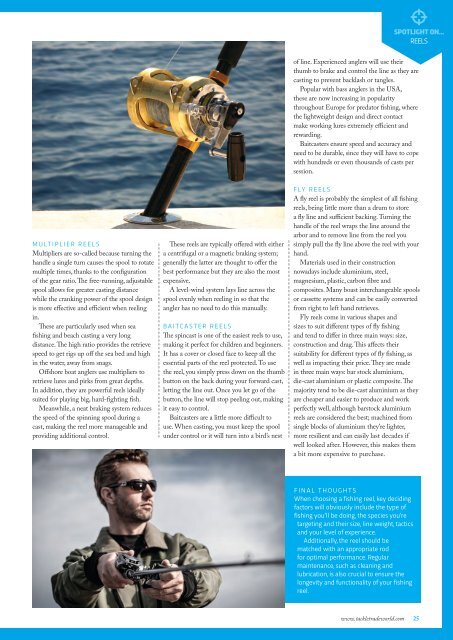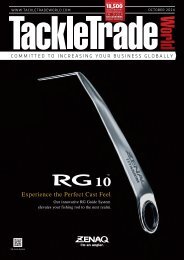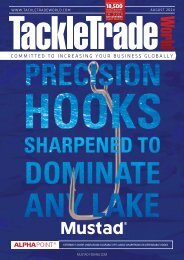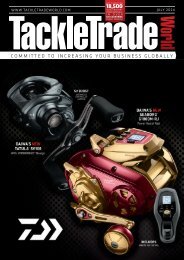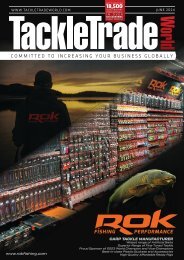Create successful ePaper yourself
Turn your PDF publications into a flip-book with our unique Google optimized e-Paper software.
SPOTLIGHT ON...<br />
Reels<br />
Multiplier Reels<br />
Multipliers are so-called because turning the<br />
handle a single turn causes the spool to rotate<br />
multiple times, thanks to the configuration<br />
of the gear ratio. The free-running, adjustable<br />
spool allows for greater casting distance<br />
while the cranking power of the spool design<br />
is more effective and efficient when reeling<br />
in.<br />
These are particularly used when sea<br />
fishing and beach casting a very long<br />
distance. The high ratio provides the retrieve<br />
speed to get rigs up off the sea bed and high<br />
in the water, away from snags.<br />
Offshore boat anglers use multipliers to<br />
retrieve lures and pirks from great depths.<br />
In addition, they are powerful reels ideally<br />
suited for playing big, hard-fighting fish.<br />
Meanwhile, a neat braking system reduces<br />
the speed of the spinning spool during a<br />
cast, making the reel more manageable and<br />
providing additional control.<br />
These reels are typically offered with either<br />
a centrifugal or a magnetic braking system;<br />
generally the latter are thought to offer the<br />
best performance but they are also the most<br />
expensive.<br />
A level-wind system lays line across the<br />
spool evenly when reeling in so that the<br />
angler has no need to do this manually.<br />
Baitcaster Reels<br />
The spincast is one of the easiest reels to use,<br />
making it perfect for children and beginners.<br />
It has a cover or closed face to keep all the<br />
essential parts of the reel protected. To use<br />
the reel, you simply press down on the thumb<br />
button on the back during your forward cast,<br />
letting the line out. Once you let go of the<br />
button, the line will stop peeling out, making<br />
it easy to control.<br />
Baitcasters are a little more difficult to<br />
use. When casting, you must keep the spool<br />
under control or it will turn into a bird’s nest<br />
of line. Experienced anglers will use their<br />
thumb to brake and control the line as they are<br />
casting to prevent backlash or tangles.<br />
Popular with bass anglers in the USA,<br />
these are now increasing in popularity<br />
throughout Europe for predator fishing, where<br />
the lightweight design and direct contact<br />
make working lures extremely efficient and<br />
rewarding.<br />
Baitcasters ensure speed and accuracy and<br />
need to be durable, since they will have to cope<br />
with hundreds or even thousands of casts per<br />
session.<br />
Fly Reels<br />
A fly reel is probably the simplest of all fishing<br />
reels, being little more than a drum to store<br />
a fly line and sufficient backing. Turning the<br />
handle of the reel wraps the line around the<br />
arbor and to remove line from the reel you<br />
simply pull the fly line above the reel with your<br />
hand.<br />
Materials used in their construction<br />
nowadays include aluminium, steel,<br />
magnesium, plastic, carbon fibre and<br />
composites. Many boast interchangeable spools<br />
or cassette systems and can be easily converted<br />
from right to left hand retrieves.<br />
Fly reels come in various shapes and<br />
sizes to suit different types of fly fishing<br />
and tend to differ in three main ways: size,<br />
construction and drag. This affects their<br />
suitability for different types of fly fishing, as<br />
well as impacting their price. They are made<br />
in three main ways: bar stock aluminium,<br />
die-cast aluminium or plastic composite. The<br />
majority tend to be die-cast aluminium as they<br />
are cheaper and easier to produce and work<br />
perfectly well, although barstock aluminium<br />
reels are considered the best; machined from<br />
single blocks of aluminium they’re lighter,<br />
more resilient and can easily last decades if<br />
well looked after. However, this makes them<br />
a bit more expensive to purchase.<br />
Final thoughts<br />
When choosing a fishing reel, key deciding<br />
factors will obviously include the type of<br />
fishing you’ll be doing, the species you’re<br />
targeting and their size, line weight, tactics<br />
and your level of experience.<br />
Additionally, the reel should be<br />
matched with an appropriate rod<br />
for optimal performance. Regular<br />
maintenance, such as cleaning and<br />
lubrication, is also crucial to ensure the<br />
longevity and functionality of your fishing<br />
reel.<br />
www.tackletradeworld.com<br />
25


